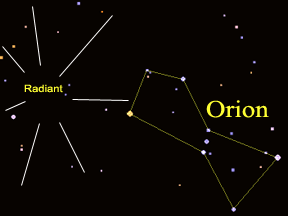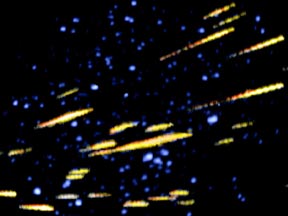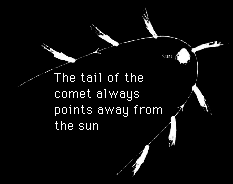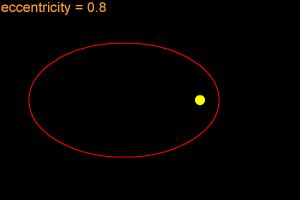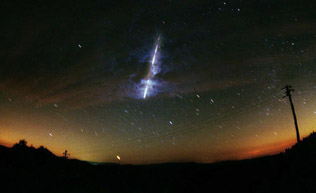Click on image for full size
Original Windows to the Universe artwork by Randy Russell.
Orionid Meteor Shower
The Orionid meteor shower is one of several major meteor showers that occur on roughly the same date each year. The Orionids typically "peak" (are at their greatest level of activity) around October 21st. The Orionid shower's name is derived from the fact that its meteors appear to fan out from a point in sky, called the shower's "radiant", which lies within the constellation Orion.
As is the case with most meteor showers, it will be possible to see Orionid meteors for several days before and after the peak on the 21st. In fact, it is sometimes possible to see some Orionids as early as October 15th and to continue to spot a few up to October 29th. At this shower's peak observers can typically see as many as 20 "shooting stars" per hour under dark skies (away from city lights). However, the Orionids, as compared to other meteor showers, present a highly variable celestial show. The number of meteors visible at the shower's peak can change quite a bit from year to year in an unpredictable fashion. Also, the exact date of the peak activity and the number of meteors visible on days before and after the peak are quite variable from one year to the next.
The shower's radiant rises above the horizon around 11 PM local time, though it will be possible to see Orionids earlier in the evening. The radiant reaches its highest point in the sky around 3:30 AM. In general, the best time to view meteors is between midnight and dawn. Don't worry if you're not a night owl, though, for it is usually possible to spot at least some Orionids early in the evening. Observers in most of the United States can use our sky maps to find Orion (try the 2 AM maps for October 15th). Observers in other locations can use an online, interactive sky chart to locate Orion; an example, developed by the folks at "Sky & Telescope" (a well-known astronomy magazine), is listed and linked to near the bottom of this page. Even if you cannot spot Orion, don't worry; meteors can be seen in any part of the sky, so all you need to do is go outside in late October and look up. Orion will be somewhere in the southeastern sky as viewed from the northern hemisphere, or somewhere in the northeast if you live south of the equator. 2007 should be an average year for viewing the Orionids. The moon will be in its waxing gibbous phase (almost full) when the Orionids peak on October 21st, so the Moon's light will make it harder to see meteors. However, the Moon will set in time for the best meteor observing period each night, which is between midnight and dawn.
The Orionids are actually bits of dust that have been shed over the centuries by Halley's Comet! The dust, which spews forth from the comet's nucleus each time it passes near the Sun, gradually spreads out over the entire orbit of the comet. If Earth's orbit happens to cross the comet's orbit, the swarm of debris scattered along the comet's orbit is visible to us as a meteor shower. Since the Earth crosses the comet's orbit at the same time each year, each meteor shower is predictably visible at the same time of year, year after year. Earth actually crosses the orbit of Halley's Comet twice each year. The eta Aquarids, another meteor shower visible in May, mark the other time each year that our planet passes through the debris that Halley's Comet has left scattered along its orbit.
Most meteors in a shower are quite small, about the size of a grain of sand. Orionids are among the fastest-moving meteors. These meteors typically strike our atmosphere while traveling at speeds around 66 km/s (about 148,000 mph). Because of their high speeds, Orionids typically leave long, glowing trails in the sky. Only the Leonid meteors, which are visible in November, move faster than the Orionids. Leonids typically have speeds around 72 km/s.
The Orionids were discovered around 1839 or 1840 by Edward C. Herrick. The first precise observations of the shower were made by Alexander Herschel in 1864, who determined the location of the shower's radiant the following year. The first measurements of the peak rates of meteors from this shower were made in 1892. Charles Olivier speculated in 1911 that the shower was associated with Halley's Comet, although it was several years before this connection was generally accepted by astronomers.


